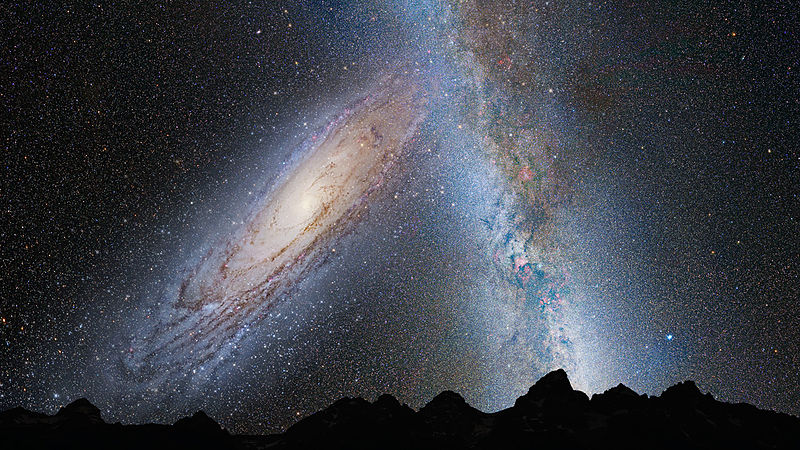Super Cool Science S#!t #7 - A Galactic Fender Bender
Doom approaches our beloved Milky Way galaxy...
A giant is flying right at us, and all mankind will be able to do is sit back and watch. That is, if mankind still exists in roughly 4 billion years... Our closest neighbor, and the largest galaxy in the local group, is careening toward our home, the Milky Way, the local group's second largest galaxy. No one currently alive will ever experience any part of the event that is to come, because the two galaxies are still roughly 2.5 million light years apart, but in about 3.75 billion years, this is what denizens of Earth, if there are any, would likely see in the sky:

Source

Nothing to fear
The image above looks intimidating. Like some giant monster here to swallow up everything we know. The Andromeda galaxy contains about one trillion stars, compared to the Milky Way's 200-400 billion. It also measures in at approximately 220,000 light years across, the Milky Way being estimated at 100,000 light years in diameter. The third largest galaxy in the local group, the Triangulum galaxy, will have a part to play as well, dancing around the outskirts of the collision, possibly scooping up stars in the process. The facts seem stacked against us, until you factor in the distance between individual stars.
The closest star to our own is Proxima Centauri at a staggering 4.2 light years away. Even when these two giant clumps of stars come together, it's very unlikely that even a single collision between individual stars will occur. The stars will get jostled about, and some will even be thrown out of the resulting elliptical galaxy. Here's a simulation video of the whole thing from the YouTube channel VideofromSpace:

Milkomeda
The collision is likely to send our solar system a little further from the center of the galaxy than we are now, and it's unlikely (about a 10% chance), that we'll be flung to the outer regions. Even though our star's orbit will be affected, the solar system itself will probably not, and in about 5.1 billion years, Earth's night sky would be flooded with light. The two bright spots in the image below are the two bulges, or cores of the galaxies that once existed.


Sources:
- https://www.nasa.gov/mission_pages/hubble/science/milky-way-collide.html
- https://www.cfa.harvard.edu/news/su200822
- http://www.nature.com/news/andromeda-on-collision-course-with-the-milky-way-1.10765
- http://phenomena.nationalgeographic.com/2014/03/24/scientists-predict-our-galaxys-death/

If you enjoyed this post, consider upvoting and/or resteeming it. I try very hard to deliver quality, original content, and often my posts fly under the radar. I'm still a growing minnow, and I could use all the help I can get! Now that I've gotten that out of the way, you have yourself a wonderful day!
Ready to learn more? Checkout my recent post about
The Exponential Expansion of the Universe!

I love space stuff man. I was rapt when watching that video!
Ridiculous, isn't it? Too bad we won't be around to see it...
Speak for yourself mortal! ;O)
good information....keep up the good work